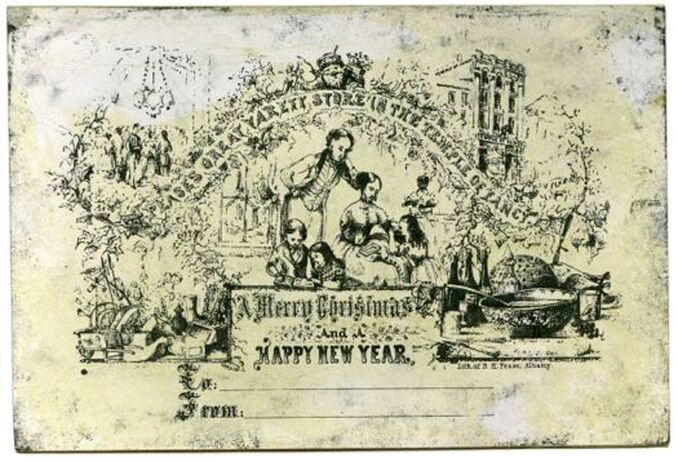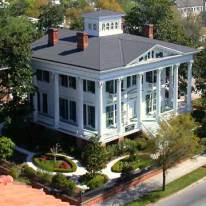By: Thomas Thompson, Bellamy Mansion Intern and UNCW History Major
|
With the holiday season over, everyone has put away their Christmas decorations or still needs to put them away. Depending on how sentimental one is, people are also putting away Christmas cards from loved ones. Some may not think much about a Christmas card other than it is an easy way to give a Christmas greeting to people. However, the history of commercially produced Christmas cards is more intriguing than one would think. By the mid-1800s, Christmas cards started being developed as a quick and cheap way to send a greeting to the people you care about. For card publishers of the time, there was an effort to make the images on Christmas cards stand out. It is not known what kind of Christmas greetings the Bellamy’s sent to loved ones, but this was a tradition taking form during the first Christmas they spent in the mansion in 1861. In the United States, the commercial printing of Christmas cards began with R.H. Pease in Albany, New York in the 1850s. The subject of Pease’s cards were associated with what we would call modern Christmas traditions, such as Santa, reindeer, and other Christmas fare. By 1870, it was Louis Prang who had helped to popularize the Christmas card in the United States. Prang was a German native who immigrated to the United States in 1850. He first got work as a wood engraver for an art department, and Prang eventually formed a business with a partner doing lithographic and copper plate manufacturing. Prang become the sole owner of the business in 1860 and named it L. Prang and Company. With this company they would print items like business cards, mailing labels, and advertisements. Prang had made improvements to his business by introducing multi-colored lithographic printing and using zinc plates. Around this time Prang started to make a series of over-sized cards called “Prang’s Illuminated Christmas Cards.” Prang’s business became incredibly successful. In 1875, Prang’s company began printing Christmas greetings on their cards--an idea of a business partner’s wife. Many of Prang’s first cards were quintessential of Victorian cards which were small and printed on one side. Along with that the art also reflected Victorian aesthetics. Cards included imagery of flowers, children, birds, or landscape scenes. Eventually Prang started to make Christmas cards with imagery that we associate moreso with Christmas today such as holly and mistletoe. Prang also increased the size of the cards and decorated both sides of the card. Prang saw that there was a potential to produce and market cards beyond Christmas themes. He used greeting cards as a way to introduce fine art into the homes of the masses on a small but affordable scale. This cheap cost was thanks to Congress standardizing mail delivery which made it more reliable, cheap, and faster to send mail. With companies printing out a great deal of Christmas cards concentrated on the aesthetic and finer arts of the time, there were some Christmas cards that stuck out more than the others. Some cards had strange designs that range from dead robins, dancing frogs, and little girl heads on flowers. Not much is known as to why these cards were designed for Christmas. One explanation from Katie Brown of York Castle Museum is that many of the cards during this time period were meant to be conversation pieces. Victorians collected cards they had received and put them into scrapbooks. Another explanation for the peculiar iconography, is due to mail delivery being more affordable for people. When mailing of letters and cards became cheaper, the production of cards simultaneously became cheaper. This cheaper production leads to a wide variety of imagery for consumers. For Victorians there was more of an interest in having a multitude of images presented on their cards. They were not concerned necessarily with seeing typical Christmas images. Victorians were interested in animals, and during this time Charles Darwin’s On the Origins of Species and changed what people thought about animals. Looking at the images above we can see that they were some whimsical and bizarre pieces. We see that Christmas cards came at both ends of the spectrum around this time. Either showcasing the fine arts or just being downright silly. The aesthetic cards of the Victorian period are more comparable to modern Christmas cards, but I do not think you would find cards today with dead birds on them. Who knows maybe Hallmark might try to bring back designs of dead birds and or daisyheads.
By: Thomas Thompson, Bellamy Mansion Intern and UNCW History Major
1 Comment
8/17/2023 12:29:00 am
When it comes to dropping off your rental car at Charlotte Airport, you can find ample signage within the airport grounds to guide you. Following all directions, travel along the airport roadways towards the Hourly Deck.
Reply
Leave a Reply. |
About UsThe museum
offers tours, features changing exhibits, and provides venue space for
weddings and special events. 503 Market Street
Wilmington, NC 28401 910.251.3700 Tours: Tues - Sat 10am- 4pm Sunday 1pm- 4pm Categories
All
Archives
April 2020
|


